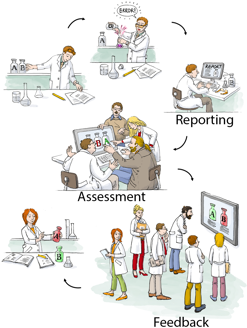Test procedures
The feasibility of studies involving new surgical procedures, or of recruiting researchers new to the use of established procedures on animals, must be established before animals are committed to such projects. The technical skills of those to be involved are of critical importance and must be established beyond the standards assumed upon completion of theory-based training programmes and familiarity with the related literature. Technical aptitude is best acquired by direct collaboration of the new researcher with individuals possessing such skills in the intended species. Where such individuals are not available, “dry-runs” using cadavers should be considered. If legislation does not forbid them, the use of acute experiments (where the animal is humanely killed by an anaesthetic overdose while still unconscious) as pilot studies may also be discussed. It should not be assumed that researchers adept in complex procedures in one species, for example humans, are similarly adept on others, such as pigs.
See also section 13 on Experimental Procedures: section 13a and section 13b.
More resources
- Injection or infusion? Insights for your next animal dosing investigation, Charles River webinar, 27 January 2022
- Adjuvants and Antibody Production: Dispelling the Myths Associated with Freund's Complete and Other Adjuvants (Stils, 2005)
- Replacing animal-derived antibodies with animal-free affinity agents (NC3Rs hub)
- EURL-ECVAM Recommendation on Non-Animal-Derived Antibodies (FAQs)
- Tolerable Levels of Nonclinical Vehicles and Formulations Used in Studies by Multiple Routes in Multiple Species With Notes on Methods to Improve Utility (Gad et al., 2016)
- Nonexperimental Xenobiotics: Unintended Consequences of Intentionally Administered Substances in Terrestrial Animal Models (Perkins & Hankenson, 2020)
- Toxicology and regulatory sciences resources
- Careful use of fetal calf serum - a video from The Netherlands National Committee
- Alternatives to foetal calf serum
- A simple procedure for estimation of total body surface area and determination of a new value of Meeh's constant in rats (Gouma et al., 2012)
A Laboratory Critical Incident and Error Reporting System for Experimental Biomedicine. Ulrich Dirnagl, Ingo Przesdzing, Claudia Kurreck & Sebastian Major (2016):


